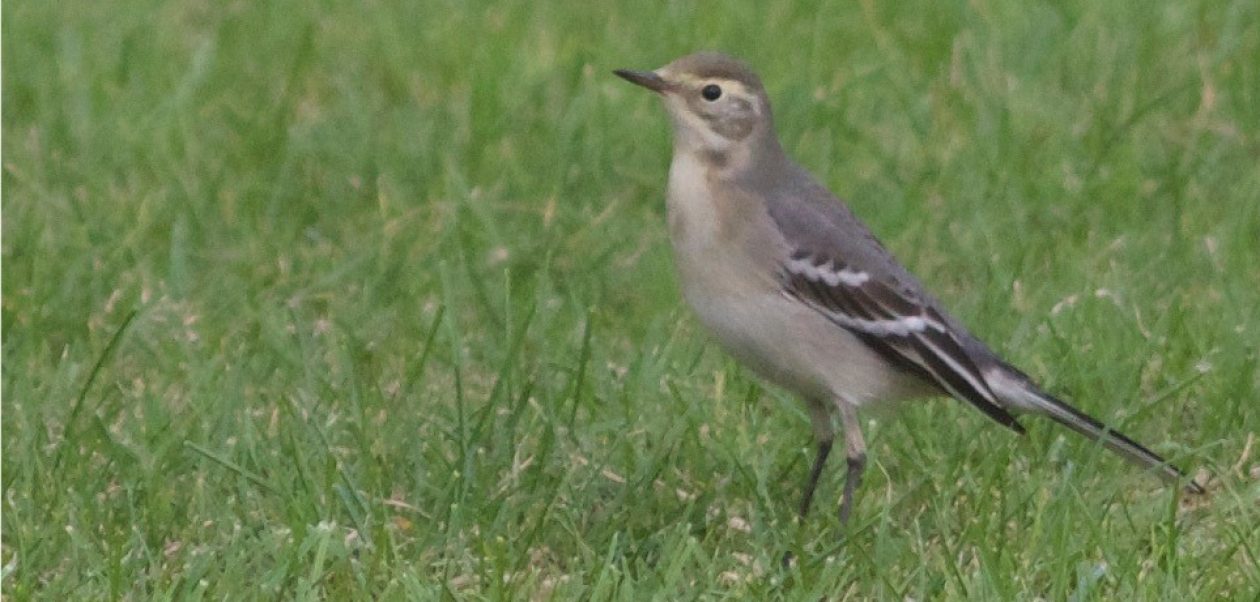142 species so far this year 144 species by the same time last year
A total of 87 species were recorded in August compared with an average of 91 species in Augusts in the ten previous years (only March this year has scored a greater than average total). There were only four additions to the year list (compared with 12 in 2018) and so we are trailing last year now, for the first time this year. The Crossbills on 7th and 8th were our first for six years but pride of place must go the Brown Booby which shocked us with its brief appearance and has now been followed by records from Cornwall, France and even Newfoundland in Canada. The sighting, backed up by photos and our research, will be submitted to the British Birds Rarities Committee in due course!
31st
A quiet morning but a Ruff was a new bird for the year. A flock of 19 Redshanks flew west and single Fulmar and Swift were noted. There was a steady trickle of Swallows, a few Sand Martins and Yellow Wagtails and a Wheatear.
30th
Sunny with a light SW wind. A Fulmar flew east, there were five Little Egrets on the Hampton Flats and a Grey Heron was fishing along the beach. Two Whimbrel came in from the east, rested on the beach for ten minutes, before continuing west. Four Sand Martins and c30 Swallows flew west, there were four Meadow Pipits and a Yellow Wagtail in the grassland, a Whinchat in the marsh and a Wheatear on the grass west of the Lang Court scrub. There were five Whitethroats and a Willow Warbler in the scrub, another Whitethroat along the east bank, where there were also four Blackcaps and three Long-tailed Tits. A Kingfisher was heard by the wooden bridge and Linnets are beginning to flock with 13 seen together.
A weasel shot across the path near the Obs.
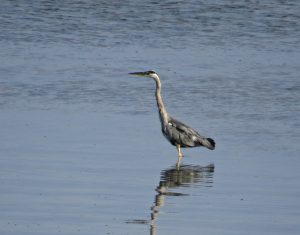
Grey Heron – Geoff Burton
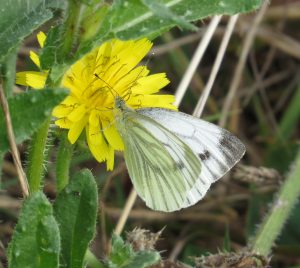
Green-veined White – Geoff Burton
29th
Cloudy and calm. Two Gannets, a Peregrine and a Whimbrel flew west. A Green Sandpiper was seen along the lower brook. Seven Sand Martins, 25 Swallows and four Yellow Wagtails also flew west. A Willow Warbler was heard calling at the Obs and two Jays, along the upper brook, were collecting acorns.
28th
Cloudy, calm with light rain showers. Waders included two Redshanks and a flock of seven Knot with seven Bar-tailed Godwits west and a single lingering Whimbrel. Three Yellow Wagtails flew west, two Whinchats were in the grassland and a Wheatear was on the shingle ridge. A Willow Warbler was calling from an oak bush in the grassland.
27th
Another sunny, calm and very warm day although we are promised change. Waders included four Knot,with the Ringed Plovers on the beach, and two Redshanks. There were two Wheatears on the shingle ridge, two Meadow Pipits on the dried-out Marsh Pool were the first of the season and warblers included another Reed Warbler, a Lesser Whitethroat and a Willow Warbler. The Kingfisher continues to be seen almost daily.
A Small Copper by the Obs was our 22nd species of the year. Of the regular species on Clouded Yellow and, strangely enough, Small Tortoiseshell remain to be seen.
26th
Sunny, calm and very warm. One Whimbrel on the beach flew off west, a Greenshank was heard calling and a flock of ten Teal flew west. Four Yellow Wagtails flew west, our first returning Reed Warbler was in the scrub, a Lesser Whitethroat was along the east bank and a Kingfisher was along the middle brook. A total of 586 House Sparrows left the roost in the bushes opposite the Obs betwen 6.25-55 am. Totals of 589 in 2018 and 2017 and 544 in 2016, at the same time of the year, suggest a remarkably stable population.
Butterflies included the daily Painted Ladies, Small Heath and Speckled Wood.
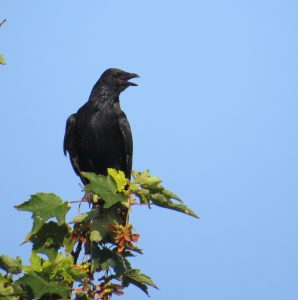
A Carrion Crow seeks out the tallest trees in the churchyard to catch the breeze on such a hot day – Geoff Burton
24th
Sunny, calm and warm. A Fulmar (our first since June) flew west over the shingle ridge and two Grey Herons also flew west. A flock of five Teal followed closely by five Mallards flew west. Waders included the highest counts of Ringed Plovers (54) and Turnstones (94) so far the is Autumn, a Whimbrel and a Green Sandpiper. A party of 14 Common Terns flew east. Alerted to the presence of a Ring-necked Parakeet in the usual way (raucous screams), the bird flew west into the sewage works, returning east a few minutes later; a new bird for the year. Our second Whinchat of the year was in the scrub, a Wheatear was on the shingle ridge, a Kingfisher along the middle brook and warblers included Lesser Whitethroat, Chiffchaff and Willow Warbler.

Whinchat – Geoff Burton
22nd
Sunny with a light westerly wind. A Greenshank flew west. A juvenile Mediterranean Gull on the beach was moulting into first-winter plumage. Flocks of Common Terns totalling 120 birds flew west during the morning. Three Sand Martins flew west, c20 Swallows and ten Yellow Wagtails were in the area, a Wheatear was on the beach, and a Willow Warbler and a Chiffchaff were also seen.
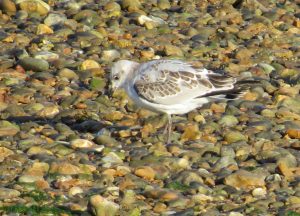
Mediterranean Gull – Geoff Burton
21st
Sunny, calm and warmer. A single Great Crested Grebe close inshore was the first for some time. Seven Whimbrels flew west and a Common Sandpiper was perched on the groynes amongst the Turnstones. A Hobby flew over the sewage works, a Great Spotted Woodpecker flew into Lang Court and onto the sewage works from the west, a Grey Wagtail was in flight over the sewage works, two Jays were near the scout hut and a juvenile Willow Warbler was at the Obs.
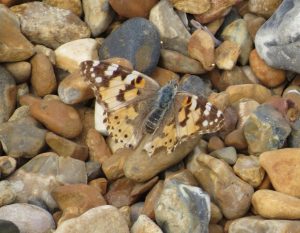
Painted Lady – Geoff Burton
20th
Ted made an early morning visit noting Whimbrel, Green and Common Sandpipers, four Redshanks and a Sanderling. There were also four Yellow Wagtails and a Sedge Warbler. Later, Andy saw a Raven flying SW at 10.35 am (only our third record for the site).
Butterflies included Painted Lady, Holly and Common Blues, Small Heath, Speckled Wood and Brown Argus, also plenty of Migrant Hawkers, a few Southern Hawkers and a male Large Velvet Ant.
19th
Sunny with a moderate SW wind. A brisk start to the day with flocks of Common Terns (35, 60 and 47) flying west, flocks of ten and seven Whimbrel flying west and three Redshanks on the beach. A single Knot flew west and, later, two flew west with a few Turnstones. One Swift was noted, six Swallows and eight Yellow Wagtails flew west. A Great Spotted Woodpecker flew high over the sewage works, warblers included Lesser Whitethroat, Garden Warbler and Chiffchaff and two Long-tailed Tits, the first for some time, were along the east bank and at the Obs.
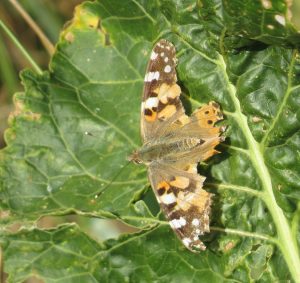
Tatty Lady – Geoff Burton
It’s frustrating when you don’t see something but it can be even more frustrating when you do. Just after 7, I saw a large, dark bird flying east low over the sea only a few hundred metres offshore. Glimpsed, through binoculars, I thought it was a juvenile Gannet but, through the scope, it looked distinctly odd! Leaving aside the rarity of juveniles here this early in the season (they are predominant in late Autumn), the all dark plumage of the upperparts, the head, neck and chest, were in stark contrast to the pure white belly. It looked a very neat bird with clear cut divisions between the dark areas and the white belly. Unfortunately, heading east early on a sunny morning, the bird was soon flying away from us and into the light. Andy was straight onto it and had the presence of mind to fire off a few shots. I called up Chris Hindle at Reculver to warn him that it was heading in his direction but the bird wasn’t seen there.
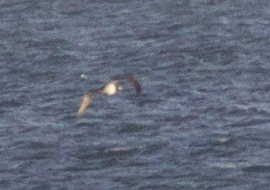
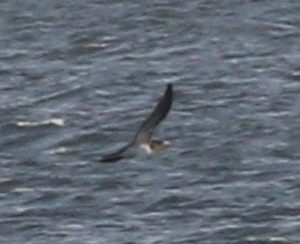
Andy Taylor
Andy and I both said Brown Booby! In all our years of Gannet watching at Swalecliffe, neither of us had seen a Gannet looking like this. The question is could a Gannet, in some sort of immature plumage, replicate these features? The photos, despite their deficiencies (sorry Andy but you know what I mean) do illustrate the features we saw. A contrasting pale bill, a contrasting white belly, and everything else uniformly dark. They also show pale underwing coverts which we did not notice through our scopes.
It would be of interest to know whether there are examples of juvenile Gannets that show such a neat dark and pure white pattern. There is an example of a Northern Gannet being initially identified as a Brown Booby but re-identified correctly, in Portugal in July this year. Photographs of this bird to do not seem to be as neatly demarcated as our bird. The distinctive features pointing to Northern Gannet in that bird included the white rump and the dark underwing. In our bird, no white rump was noticed and the photos show a paler underwing. A Brown Booby was seen in the Netherlands and Germany on 20th August 2017 (one day short of two years previously). Photographs of this bird show a pale rather than a pure white underwing which, in both cases, could be a photographic effect. Finally, Barry Wright put the two photos above into the Merlin app (result, in both cases, came out as Brown Booby!).
We saw the bird clearly but very briefly, were unprepared for it, and our photos were not the best. We would be very interested to hear any views.
17th
Sunny with a moderate SW wind. A Bar-tailed Godwit flew west at 9.15 am, a flock of seven Common Terns flew west and a Shoveler was resting on the shoreline by the Obs before flying off west. 12 Swifts flew west, warblers along the east bank included Lesser Whitethroat, Garden Warbler and Willow Warbler and a Kingfisher was along the middle brook.
Butterflies included a Speckled Wood, the first noted here since 18th June.
16th
Arnie reported 12 Oystercatchers and a Whimbrel on the beach.
15th
Sunny periods, light SW wind. There were five Little Egrets on the Hampton flats. Waders included 18 Oystercatchers and a Dunlin on the beach. Four Swallows flew west, there were c10 Yellow Wagtails, a Kingfisher and warblers along the east bank included Lesser Whitethroat, Garden and Willow Warblers.
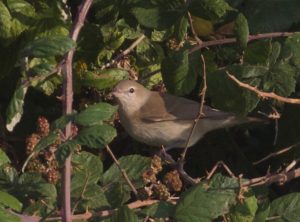
Garden Warbler – Andy Taylor
14th
Cloudy with a fresh SW wind. A juvenile Gannet flew east, a Bar-tailed Godwit flew west along the beach and a Golden Plover, our first of the autumn, flew west at 10.40 am. Other waders included single Sanderling and Dunlin on the beach. A Whinchat in the grassland was a new bird for the year (on the same date as the first last year) but disappeared as soon as it was found; there will be more! One Swift was seen and Chiffchaff and Willow Warbler were heard at the Obs.
13th
Ted, Arnie and Greg were about today. The Garden Warbler was present along the east bank again and waders included a single Dunlin, 32 Ringed Plovers and 28 Turnstones.
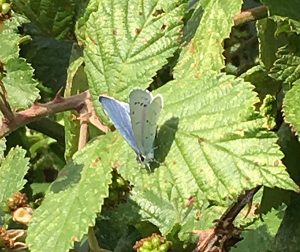
Holly Blue – Greg Herne
12th
Cloudy with showers and a light SW wind. Waders included a flock of 15 Knot west, 40 Ringed Plovers on the beach and two Common Sandpipers. A Sedge Warbler along the side of Coot Strait, a Garden Warbler along the east bank and a juvenile Wheatear on the beach were all firsts for the Autumn. Also, a Kingfisher flew up the brook, a Swift and a Yellow Wagtail flew west, and a Grey Heron, a Great Spotted Woodpecker and a Willow Warbler were also seen.
Butterflies seen included Painted Lady and Holly Blue.
10th
Sunny periods but fresh to strong SW wind and light showers. This was notably for the movement of terns. There were c30 Sandwich Terns, 120 Common Terns and four Little Terns west during the morning. Also, c50 Swifts and 12 Sand Martins flew west, there were 22 Ringed Plovers on the beach and, despite the winds, seven Whitethroats were noted in the scrub.
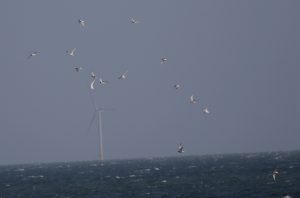
Common Terns – Andy Taylor
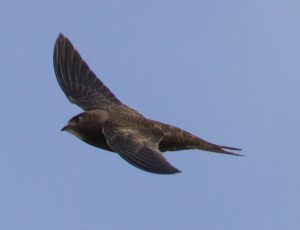
Swift – Andy Taylor
8th
Sunny with a light SW wind. A total of nine Little Egrets comprised of four in the brook, later roosting in the sewage works trees, one in the Marsh Pool and a single bird followed by three more flying west out at sea. Waders included singles of Sanderling, Dunlin and Common Sandpiper, 25 Ringed Plovers and 30 Turnstones. There were six Swifts, three Sand Martins, five Swallows and a Yellow Wagtail flying west, warblers included a Lesser Whitethroat and two Willow Warblers and a Great Spotted Woodpecker appeared briefly in the Elm Wood. On arrival, the calls of Crossbills could be heard from Lang Court but they soon ceased and none were seen.
Butterflies included Holly Blue and Brown Argus and dragonflies were Migrant Hawkers, a Southern Hawker and a Blue-tailed Damselfly.
7th
Mostly sunny with a light westerly wind. A Little Ringed Plover (our third of the autumn) was flying around the beach early morning. Other waders included 20 Sanderlings ( a big increase over the two seen up to now), and 29 Ringed Plovers. There were also five Common Sandpipers in the area. Birds of the day were two Crossbills, which flew west over the football pitch and sewage works at 7.25 am (our first here since 2013). There were two Yellow Wagtails, one on the beach and one west over the Obs, and a Willow Warbler dropped in at the Obs. An adult Moorhen was in the middle brook quite close to the site of the spillage. The diesel smell lingers and the brook looks a turgid brown colour; lets hope our hen is ok!
Butterflies included Painted Ladies and Red Admirals, a Brown Argus and mating Common Blues. Plenty of Migrant Hawkers about too.
6th
Andy noted 26 Swifts and Arnie noted a Common Sandpiper on the Marsh Pool and a Willow Warbler and the Lesser Whitethroat was seen again.
The sight of Southern Water workers cutting across the Marsh Pool kind of encapsulates the lack of joined-up thinking that has plagued “management” of this SSSI.
5th
Cloudy with a light southerly wind. Waders included a Whimbrel, a Bar-tailed Godwit and a Green Sandpiper west, a Dunlin and two Common Sandpipers on the beach and an increase to 21 Ringed Plovers. A Hobby flew low west beyond the caravan park. A total of 85 Swifts heading west included flocks of 35 and 30, there were also 23 Sand Martins and six Swallows west. A Lesser Whitethroat was seen again near the scout hut and a juvenile Willow Warbler appeared in the rose bush on the shingle mid-morning.
Not a day for butterflies but Painted Lady, Gatekeeper and Meadow Brown were seen.
3rd
Sunny with a light northerly wind. Three Gannets flew west (possibly the same ones flew east) and parties of 30 and eight Common Scoters flew west. Waders included a Common Sandpiper on the Marsh Pool, a Dunlin and 54 Turnstones on the beach. Two Mediterranean Gulls flew east over the area but, more unexpected, was juvenile Kittiwake which flew east close inshore. One Swift and a juvenile Swallow flew west and a Lesser Whitethroat was near the scout hut.
A Brimstone butterfly was the first seen here since May.
1st
Cloudy at first then sunny, light westerly wind. Rather a quiet start to the month. Waders were six Oystercatchers, 15 Ringed Plovers, one Sanderling and 50 Turnstones. Five Swifts and a Yellow Wagtail flew west, a Grey Wagtail was over the sewage works and a Lesser Whitethroat and two juvenile Willow Warblers were along the east bank.
A warm day encouraged butterflies with nine species recorded including two Brown Argus and a Painted Lady at the Obs. A Thistle Ermine moth was seen at the Obs and a number of Migrant Hawkers were also seen.
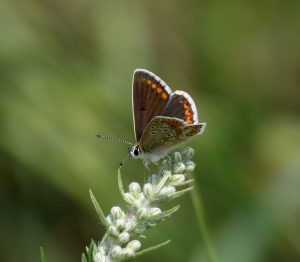
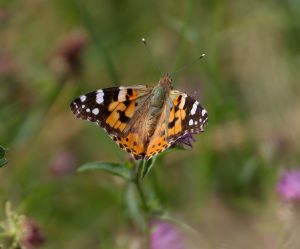
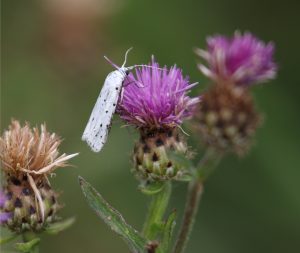
Brown Argus, Painted Lady and Thistle Ermine – Andy Taylor
After yesterday’s diesel pollution of the brook , there was much activity by Southern Water at the site. More so than there has been in the past with other pollutions. However, we were dismayed at one particular warning sign which warns against bathing or allowing dogs in the brook but implies that such “restrictions” are only temporary! This contradicts the Councils own notices which says that dogs should not be allowed in the brook under any circumstances to protect wildlife including Water Voles (which have been preyed on by dogs in the past).

Extract from permanent Council notice
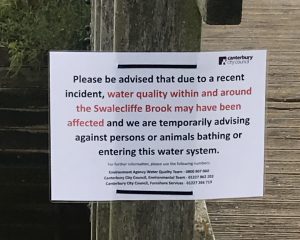
Temporary Council notice
